Thinking about swapping the UK for Sydney? You’re not alone. Every year, upwards of 50,000 Brits make the move from the UK to Australia, and Sydney ranks as the most popular destination city for movers.
Sydney pulls people in for good reasons: the beaches, the strong job market, the easy pace of life. It all adds up. But it’s still a big move, and you need a clear view of what daily life looks like and how the relocation process actually works.
This guide breaks it all down for you. We cover visas, neighbourhoods, housing, cost of living, schools, healthcare, transport and what to expect day-to-day. We also highlight the challenges as well as the benefits, so you can make an informed decision.
At 1st Move International we’ve helped thousands of people relocate from the UK to Sydney, and we know the questions that come up long before you book a flight or choose a shipping date. Whether you’re planning a fresh start, moving for work or relocating with your family, this is your practical, no-nonsense starting point for moving to Sydney.
Table of Contents
Why Move to Sydney?
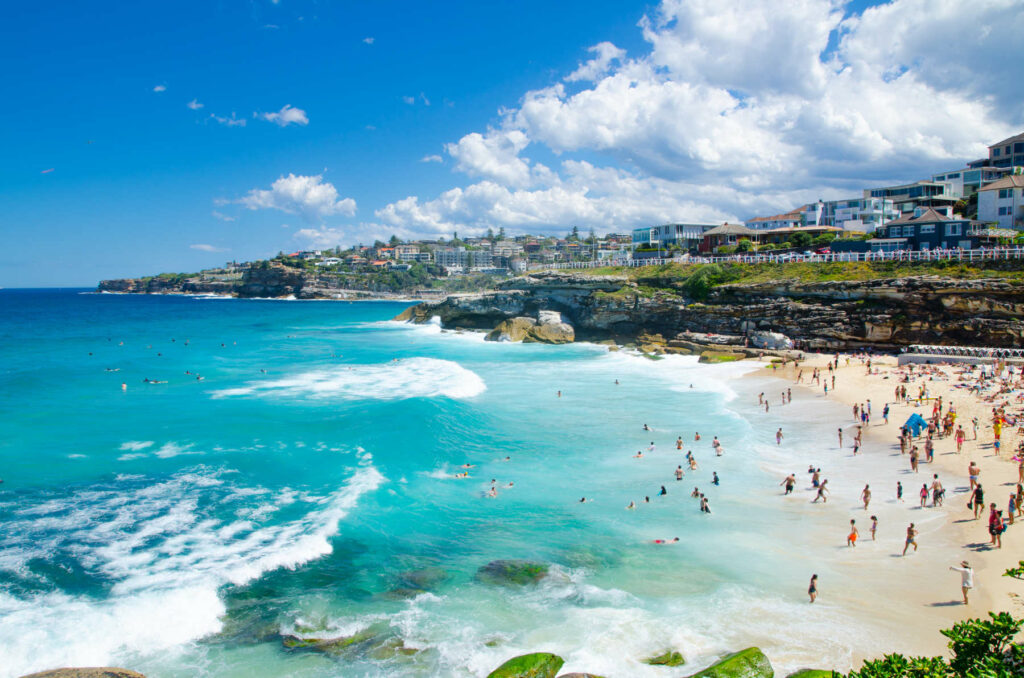
1. Year-Round Warm Weather and Outdoor Living
As with most of Australia, Sydney’s climate is a stark contrast to the grey skies you’ll be used to back in the UK. You’ll have approximately 340 sunny days annually, with winter temperatures rarely dropping below 8°C. The seasonal shift feels refreshing rather than punishing. You’ll actually want to be outside in winter. This great weather fundamentally changes your lifestyle. Outdoor dining becomes standard, weekend plans don’t require weather contingencies, and seasonal affective disorder becomes a thing of the past.
2. Strong Job Market and Career Progression
Sydney dominates Australia’s employment landscape, particularly in finance, technology, and professional services. The city houses the headquarters of most major Australian companies and attracts significant international investment. Salaries typically exceed those in other Australian cities, and opportunities for career progression are substantially broader. For professionals in banking, consulting, tech, or creative industries, Sydney offers opportunities that don’t exist elsewhere on the continent.
3. Vibrant Cultural Scene
Sydney delivers theatre, museums, live music, and dining on a scale similar to London, but with a style that reflects the city’s own laid-back character. The city attracts major international tours, supports a thriving arts scene, and offers everything from experimental theatre in Newtown to opera under the stars. Likewise, the Food culture here as just as diverse, and would put most British high streets to shame.
4. Easy Access to Beaches
Unlike Gold Coast tourist spots, Sydney’s beaches integrate into daily life. Bondi, Manly, Coogee, and dozens of smaller beaches sit within 30 minutes of the city centre. You can finish work at 5pm and be swimming by 5:45pm. Coastal walks link the beaches, ocean pools offer protected swimming, and the beach culture emphasises fitness and community.
5. Work-Life Balance
Sydney attracts people who want both career success and quality of life, not one or the other. Australia is well-known internationally for having a better work-life balance than in the UK, and Sydney embraces it more than other cities.
6. Quality Education Systems
Sydney’s state schools consistently outperform most UK comprehensives, and the selective school system offers genuine academic rigour without fee-paying. Schools like Sydney Grammar, North Sydney Boys, and James Ruse Agricultural High School deliver results that match elite British institutions. The university sector punches well above its weight. University of Sydney and UNSW both rank in the global top 25 at the time of writing, offering your children genuine options for higher education without returning to the UK.
Several international schools teach the British system, though many find the Australian curriculum broader and less exam-focused.
7. Better Healthcare System
Sydney’s healthcare system takes a lot of stress out of day-to-day life. Medicare covers most essential treatment, GP appointments are usually available within a few days, and you won’t spend months waiting for routine referrals. Many clinics bulk-bill, so you often pay nothing for standard visits. If you decide to add private cover, it’s reasonably priced and gives you faster access to specialists and elective procedures.
The system isn’t flawless, but it’s reliable, predictable, and far easier to navigate than what most people are used to in the UK.
Challenges of Living in Sydney
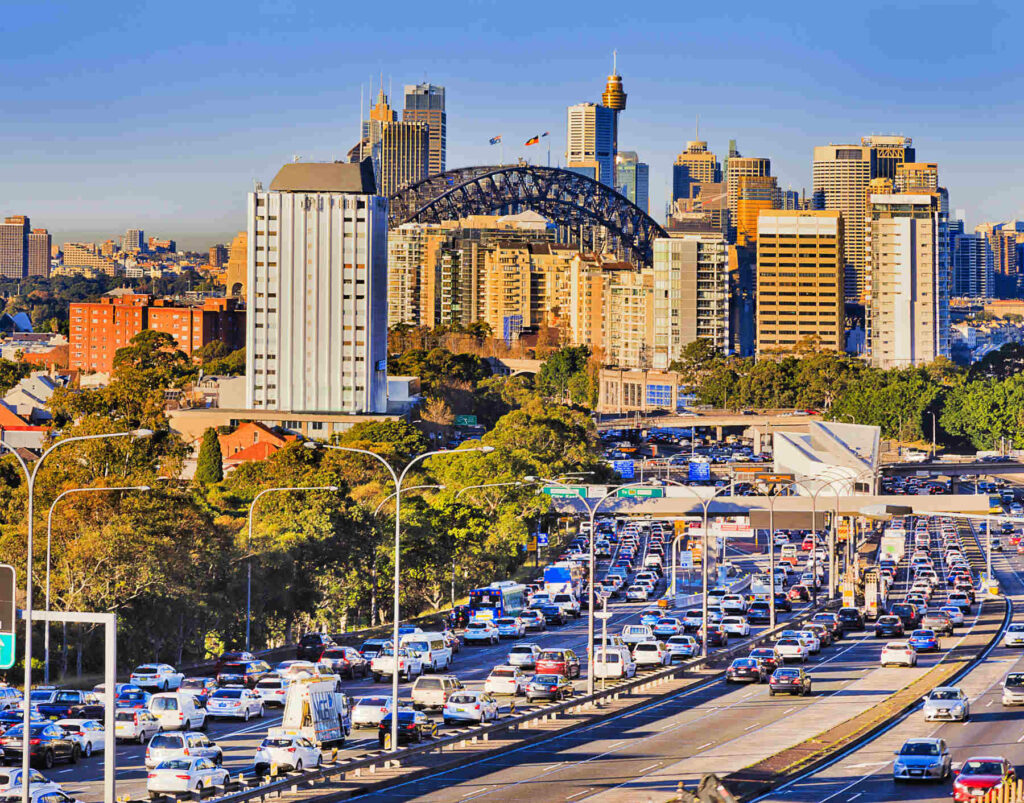
1. High Cost of Living and Housing
Sydney is genuinely expensive, and housing is the main pressure point. Rents for a three-bedroom apartment near the centre often land in the $6,000–6,800 range, and buying requires salaries and deposits that surprise even people coming from London. The lifestyle perks are real, but the financial adjustment catches many newcomers off guard. A higher salary doesn’t go as far as expected once housing is factored in.
2. Long commutes & traffic
If you choose to live further out to soften the housing costs, your commute can stretch quickly. Public transport is generally reliable, but travel times from many suburbs are longer than people anticipate, especially during peak hours. You’ll need to think carefully about where you live in relation to your job, or the daily travel can chip away at your work-life balance.
3. Distance from Home and Family
The distance from the UK hits harder in practice than it does on paper. Time zones make simple things like weekend catch-ups difficult, and trips home require serious planning and a decent chunk of money. Most expats say this becomes one of the toughest parts of living in Australia once the initial excitement settles.
As one expat put it in a reddit post comparing London to Sydney:
Comment
byu/Funny-Count1352 from discussion
inexpats
4. Building a Social Network from Scratch
Settling into a new social circle takes longer than many expect. People are friendly, but most already have established networks through school, work, or family. You’ll meet plenty of acquaintances early on, but the deeper connections take time. The expat community helps, but rebuilding the kind of support network you had in the UK is usually a slow process.
5. Climate and environmental risks
Sydney’s weather is a major draw, but it also comes with a learning curve. Summers can be hot and humid, and the wider region faces seasonal risks like bushfires and heatwaves. You’ll need to consider things like home insulation, air-conditioning, and safety planning in a way you never needed to in the UK. It’s manageable, but it’s a shift.
6. Wildlife and environment
You’ll encounter more insects and spiders than you’re used to in Britain. Most are harmless, but the frequency alone can be an adjustment. For some newcomers it’s a mild annoyance; for others, especially those with phobias, it’s a genuine hurdle.
How to Move to Sydney
Visas and Immigration: Your Route Into Australia
If you’re serious about moving to Sydney, your visa is the first and most important step. Australia doesn’t offer a simple “move here and figure it out later” option, so the right visa pathway decides everything else: your timeline, your work rights and whether the move is temporary or permanent.
The main pathways
Most UK movers fall into one of these groups:
- Skilled visas
Australia’s points-based system is the most common route for people moving to Sydney for work. It looks at your age, qualifications and experience to decide if you’re eligible. If your profession is in demand, this is usually the most direct long-term option. - Employer sponsorship
Some people move because an Australian company wants to hire them. This is a viable route if you work in a field where local skills are short, but the process takes time and usually requires a firm job offer. - Partner and family visas
If you’re joining a partner or close family member, these visas may fit better — just be prepared for longer processing times than you’d expect in the UK. - Working Holiday (18–35)
A flexible, short-term option for younger movers who want to try Australia before committing. It isn’t a long-term pathway on its own, but it’s a popular way to get local experience and decide whether Sydney feels right.
What you should do next
- Check out the Department of Home Affairs visa list for detailed information on all available visas.
- Check your occupation on the official skilled lists if you’re considering a work-based move.
- Start the process early. Six to twelve months of planning is normal.
- If your situation is complicated, speak to a registered migration agent.
- Check out our Moving to Australia guide for more detailed info on Visas (and more).
Once you have a clear visa pathway, everything else (jobs, neighbourhoods, shipping) becomes much easier to plan.
Finding Housing in Sydney

Understanding Sydney’s Neighbourhoods
Sydney’s geography dictates lifestyle choices more than most cities. The Inner West (Newtown, Marrickville, Leichhardt) is known for cafés, culture, and relative affordability. The Eastern Suburbs (Bondi, Coogee, Paddington) offer beaches and a higher price point. The North Shore (Mosman, Chatswood, Neutral Bay) suits families looking for schools and space. The CBD fringe (Surry Hills, Redfern, Pyrmont) works for people who want walkability and proximity to offices.
Commute times matter more here than distance on a map. A 15-kilometre trip can easily take 45 minutes in traffic. Figure out your work location first, then narrow your search to neighbourhoods with realistic travel times.
Rental Market Basics
Expect to pay: $600–850 a week for a two-bedroom flat in mid-distance suburbs like Ashfield, Ryde or Kogarah, and $900–1,200 a week closer to the city or beaches. Most rentals are unfurnished. You’ll need four weeks’ rent upfront (bond plus first month).
Application process
Sydney’s rental market moves quickly, so preparation helps. Inspections are brief and competitive, often with applications opening the same day. Have your documents ready (ID, proof of income, rental history or references) so you can apply immediately if you like a place. A short note explaining who you are and your move from the UK gives agents context. Flexibility on nearby suburbs or move-in dates can make a real difference.
Key platforms:
- Domain.com.au – Largest listings database
- Realestate.com.au – Second major platform
- Flatmates.com.au – Sharehouses and room rentals
Set up alerts for new listings in your target areas. Properties move quickly.
Buying Property
Budget reality: Median house prices sit around $1.7 million, units around $800,000-900,000. Stamp duty adds 4-5% to purchase costs. Foreign buyers face additional surcharges and restrictions.
Mortgage requirements: Most banks prefer a 20% deposit to avoid Lender’s Mortgage Insurance, and proving income can be harder for recent arrivals.
Auctions dominate the market, so if you’re unfamiliar with the process, a buyer’s agent can be worth the cost.
Useful Resources
- Sydney Moving Guide (sydneymovingguide.com.au) – Suburb profiles and comparison tools
- Transport NSW Trip Planner – Test commute times from potential homes
- Tenant’s Union of NSW – Know your rental rights
- Australian Taxation Office – Foreign buyer obligations and restrictions
Start your search before you arrive, but don’t commit to anything until you’ve seen it in person.
Finding Work in Sydney
Preparations Before Your Move
Many skilled visas require employer sponsorship, which means you may need a job offer before you arrive. If you’re moving on a partner visa or working holiday visa, you can start your search after landing, but early preparation still helps.
Key steps:
- Update your CV to Australian format: two to three pages, chronological, include referee contact details.
- Get qualifications assessed by relevant Australian bodies (engineers, teachers, healthcare professionals require formal recognition)
- Join LinkedIn and connect with recruiters specialising in your industry
- Research which companies actively sponsor international workers
- Prepare to explain your visa status clearly in applications
Salary Expectations by Industry
Sydney salaries generally exceed other Australian cities but cost of living consumes much of the difference. All figures below are approximate annual salaries in AUD.
- Finance & Banking: Analysts $80k-120k, Senior roles $150k-250k+
- Technology: Developers $90k-140k, Senior engineers $150k-200k, Tech leads $180k-250k
- Healthcare: Registered nurses $70k-90k, GPs $150k-300k, Specialists $200k-500k+
- Teaching: $75k-110k depending on experience and sector
- Marketing: Coordinators $60k-80k, Managers $100k-140k, Directors $150k-200k
- Trades: Electricians/plumbers $70k-120k, often higher for self-employed
- Legal: Solicitors $70k-100k, Senior associates $120k-180k, Partners $200k-500k+
Superannuation adds 11.5 percent to your package. Check whether the salary being offered is quoted with super included or added on top as both formats are common.
Job Hunting Platforms
Major job boards:
- Seek – Dominant platform, covers all industries and levels
- LinkedIn – Essential for professional roles, strong for networking and recruiter contact
- Indeed – Good coverage, particularly mid-level roles
- Ethical Jobs – Non-profit and social enterprise sector
Industry-specific platforms:
- eFinancialCareers – Finance and banking
- Jora – Trades and hospitality
- GradConnection – Graduate programmes
Recruitment agencies:
- Hays, Robert Half, Michael Page – Professional services, finance, tech
- Randstad, Adecco – Temp and contract work across industries
- Hudson – Executive and senior roles
Set up daily email alerts on Seek and LinkedIn for your target roles. Apply quickly. Positions receive hundreds of applications within days of posting.
Networking Effectively
Australian workplace culture values personal connection more than many UK professionals expect. Referrals carry weight, and warm introductions help your application stand out.
Practical networking:
- Join industry associations relevant to your field (many offer reduced rates for new members)
- Attend industry events and conferences. Eventbrite and Meetup list regular professional gatherings
- Contact British expat professional groups (British Australian Business Council, UK in Australia alumni networks)
- Reach out to people working in your target companies via LinkedIn.
- Consider informational interviews to understand the market before formally applying
Don’t undersell British experience. Sydney employers value international perspective, particularly London experience in finance and professional services. Frame your background as bringing global standards rather than needing to catch up.
Visa Sponsorship Reality
Not all employers sponsor international workers. Target larger companies, multinationals, and organisations with established sponsorship programmes.
If a job ad doesn’t mention sponsorship, assume it’s unlikely unless the employer is large or the role is in a shortage occupation.
Industries most likely to sponsor:
- Technology and IT
- Healthcare (particularly regional areas)
- Engineering
- Finance and professional services
- Education (particularly tertiary)
Less likely to sponsor:
- Hospitality and retail
- Small businesses under 50 employees
- Start-ups without HR infrastructure
- Media and creative industries (highly competitive locally)
Search “sponsorship” or “visa assistance” in job descriptions. Some roles explicitly state sponsorship availability. When it’s unclear, ask recruitment agencies before investing time in applications.
Working Temporarily While You Search
If arriving on a working holiday or partner visa, temporary work helps you understand the market whilst building local experience. Make sure your visa permits contract, temp or casual work before applying. Most do, but it’s worth checking.
Options:
- Contract roles through recruitment agencies (often lead to permanent positions)
- Hospitality and retail (flexible hours, immediate income)
- Temp agencies for administrative work
- Casual teaching or tutoring if qualified
Local experience, even tangentially related to your field legitimises your presence and demonstrates commitment to Australian employers.
Useful Resources
- Moving to Australia as a Doctor – Our in-depth guide for Doctors and Practitioners moving to Australia.
- Moving to Australia as a Lawyer – Our in-depth guide for Lawyers and Solicitors moving to Australia.
- Fair Work Ombudsman – Employment rights, award wages, workplace standards
- Australian Taxation Office – Tax File Number application (needed before starting any job)
- Assessing bodies – Engineers Australia, Australian Health Practitioner Regulation Agency, others specific to your profession
- British Australian Chamber of Commerce – Professional networking events
- Home Affairs visa finder – Understand which visas permit work and sponsorship pathways
Start building your network before you need it. The job you secure through a contact will likely be better than the one you find through cold applications.
Driving in Sydney

You can get around Sydney without a car if you choose the right neighbourhood, but many people still drive, especially if they’re living further out or juggling family schedules. The good news is that the rules and road layout will feel familiar to anyone from the UK. The habits and expectations, though, take a little getting used to.
Converting your UK licence
UK licence holders can drive in New South Wales on their UK licence for their first few months, depending on visa type. Once you’re considered a resident, you’ll need to switch to a local NSW driving licence. The process is simple: proof of ID, an address, and a short eyesight test. Most UK drivers don’t need to sit a driving test.
What driving in Sydney actually feels like
You’re still driving on the left, which is a comfort, but Sydney’s roads can be busy and the layout isn’t as predictable as in UK cities. Roads wind, hills are common, lanes merge suddenly and some motorways have tolls that need electronic tags.
A few things UK drivers usually notice:
- Lane discipline is looser than the UK.
- Merging is quicker, and people expect you to commit.
- School zones have strict speed limits and heavy enforcement.
- Wet weather demands respect. Sydney storms can be intense.
Toll roads
Sydney has a lot of toll roads, and most use electronic tolling rather than physical booths. If you’re driving regularly, it’s worth getting an e-tag or setting up an online account so you can pass through tolls without extra fees.
Parking
Parking rules vary by suburb, and some areas near beaches or transport hubs are heavily patrolled. If you’re planning to live in the Eastern Suburbs, Inner West or North Shore, factor parking into your housing search.
Apartment buildings often include one parking space but not always two.
Getting by without a car
If you choose to live in a well-connected inner suburb, you might not need a car at all. Sydney’s buses, trains, ferries and light rail cover a lot of ground, and contactless payments make it easy to use. Many new arrivals hold off on buying a car until they understand their commute and neighbourhood better.
Should you ship your car?
If you’re thinking about bringing your UK vehicle with you, it’s absolutely possible.
Autoshippers, our sister company, handles UK to Australia car shipping and can guide you through every step of the process or offer free advice. They can arrange collection, shipping, customs clearance and help with Australian compliance requirements. For an accurate quote, you can visit their website or simply search for car shipping UK to Australia.
Financial Essentials for UK Movers in Sydney

Getting your finances set up early makes your first few weeks in Sydney far smoother. The good news is that most UK movers find the process straightforward once they know what to expect.
Opening a bank account
Most major Australian banks let you start the process before you arrive, then complete it in a branch once you have an Australian address. You’ll need your passport, visa details and some basic ID. Accounts work much like the UK, and mobile banking apps are widely used.
Popular banks include Commonwealth Bank, ANZ, Westpac and NAB. Fees vary, so it’s worth comparing options, especially if you plan to transfer money regularly from the UK.
Getting a Tax File Number (TFN)
A TFN is essential if you want to work in Australia. You apply online after you arrive using your passport and local address. It’s quick to set up, and most employers won’t onboard you without one.
Check out our Australia tax guide for everything you need to know about Tax in Australia vs the UK.
Understanding superannuation
Superannuation is Australia’s pension system. Employers contribute a set percentage of your salary into a super fund. You don’t need to arrange this yourself, but you can choose your own fund if you prefer. It’s worth doing a little research once you’ve settled in, especially if you expect to work in Australia long term.
Everyday costs
Sydney can feel more expensive than the UK in certain areas, especially rent, groceries and childcare. Eating out varies. High-end spots are pricey, but everyday cafés are good value. Transport costs depend on how often you use toll roads and public transport. We’ll cover specific cost comparisons in detail in the cost-of-living section later in the guide.
Money transfers
If you’re moving savings or sending money back to the UK, look into specialist currency transfer services. Using your bank will work, but fees and exchange rates are often less favourable. Providers focused on UK–Australia transfers can offer much better value.
Once you’ve sorted your bank account, TFN and super, your financial admin becomes much easier. Most people get these done within their first couple of weeks.
Shipping Your Belongings to Sydney
Moving your life 17,000 kilometres requires an international removals company that understands both UK logistics and Australian customs complexity.
Start by requesting detailed quotes from multiple international movers. Look beyond the headline price. What’s included and the quality and reliability of the service matters more than the total, particularly for a move as complex as Australia.
Does the quote cover packing materials, customs clearance, quarantine inspections, delivery to your Sydney address?
Transit time for most movers can be up to 18 weeks (or more) door-to-door. The good news is, with 1st Move we can get you there in closer to 8. If you’re curious how, simply request a quote or check out our removals to Australia services.
Customs and Biosecurity
Australian Border Force doesn’t tolerate ambiguity. Your removals company should manage the entire customs process, including the detailed inventory required for clearance. Biosecurity requirements change frequently. Competent companies stay current and guide you through restrictions before problems arise.
Items requiring special treatment:
- Wooden furniture needs fumigation certificates
- Outdoor equipment, gardening tools, and sporting goods require thorough cleaning and declaration
- Some items are permanently prohibited—certain foods, plants, and materials cannot enter Australia regardless of treatment
If you’d like to learn more about removals to Australia, contact us or request a free quote. Moving to Sydney involves enough challenges without worrying whether your belongings will arrive intact and on time.
Moving with Pets
Australia has strict biosecurity rules, but plenty of UK families relocate to Sydney with their pets every year. The process takes organisation, but it’s entirely doable as long as you follow the timelines and requirements closely.
What to expect
Cats and dogs coming from the UK must meet vaccination and testing requirements and complete a quarantine stay on arrival. The rules are clear, but the lead time catches some people out. Certain tests and treatments must be done months in advance.
For detailed guidance on exactly how to import a cat or dog into Australia, the Australian Government provides an excellent resource with everything you’ll need to know.
Using a pet relocation specialist
Most movers use a professional pet transport company to handle the paperwork, vet checks, flights and quarantine bookings. It removes most of the stress and helps avoid mistakes that can delay your pet’s travel.
A good provider will lay out the full timeline, book flights compatible with animal transport rules and ensure you meet every step of Australia’s import requirements.
Quarantine
Pets arriving from the UK complete their quarantine at a government-run centre. The stay isn’t long, but it’s mandatory. Once cleared, you collect your pet or arrange onward transport to your new home in Sydney.
Planning ahead
The key is starting early. As soon as you know you’re moving, speak to a pet relocation specialist and your vet so you can follow the correct sequence of tests and vaccinations. Leaving things too late can push timelines back.
Once your pet is cleared and home with you, life in Sydney is easy. The city is full of dog-friendly beaches, parks and walking trails.
Best Neighbourhoods in Sydney
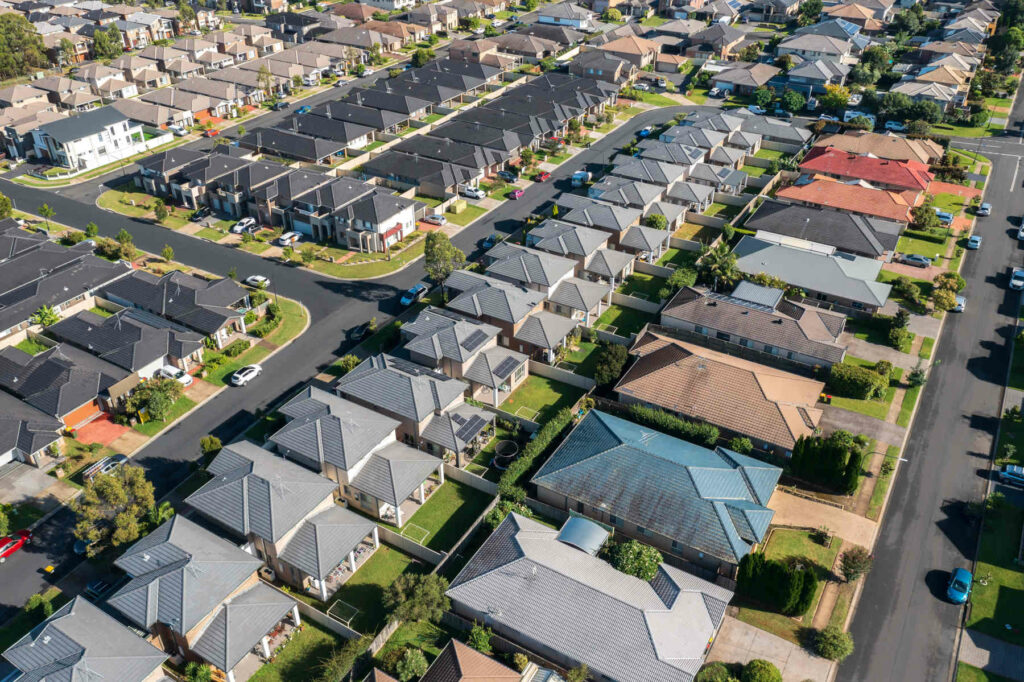
Sydney isn’t one city so much as a collection of distinct pockets, each with its own pace, price point and personality. Where you choose to live shapes everything: your commute, your social life, even how often you’re at the beach. Here’s a breakdown of the areas most UK movers gravitate towards, what they’re like and who they suit.
Beachside living

If your idea of Sydney involves morning swims and coastal walks, the beach suburbs will be hard to resist. They’re lively, outdoorsy and packed with cafés, but you’ll pay a premium for the privilege.
Popular areas: Bondi, Coogee, Bronte, Clovelly, Manly, Freshwater
Best for: young professionals, fitness lovers, social lifestyles
What to expect: higher rents, parking challenges, brilliant weekends
The Eastern Suburbs beaches (Bondi, Bronte, Coogee) have a buzzy, international feel. Manly and the Northern Beaches offer a slightly calmer, more local vibe with a real community feel.
Inner-city energy
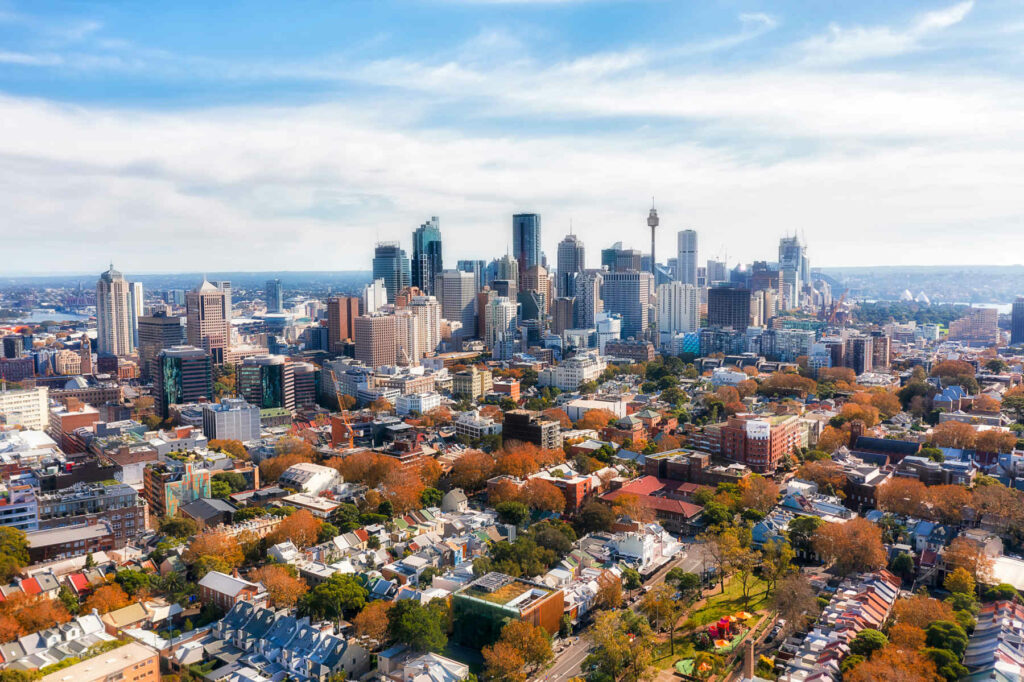
Sydney’s inner suburbs blend converted terraces, great food, easy transport and a creative scene. They’re walkable and well-connected, which makes them perfect if you’re not planning to buy a car immediately.
Popular areas: Surry Hills, Darlinghurst, Redfern, Newtown, Glebe
Best for: renters, creatives, professionals who want city living
What to expect: excellent public transport, great nightlife, smaller living spaces
These neighbourhoods feel closest to what UK newcomers expect from urban living. They’re lively and always full of things to do.
Leafy and family-friendly

If you want more space, quieter streets and good schools, the North Shore is a clear favourite. It feels suburban in the best possible way: green, safe and calm.
Popular areas: Mosman, Neutral Bay, Cremorne, Chatswood, Lane Cove, Wahroonga
Best for: families, those prioritising schools and space
What to expect: well-kept homes, village-like high streets, reliable transport
It’s one of the pricier parts of Sydney but extremely popular with UK families because of its stability and strong education options.
Up-and-coming inner suburbs
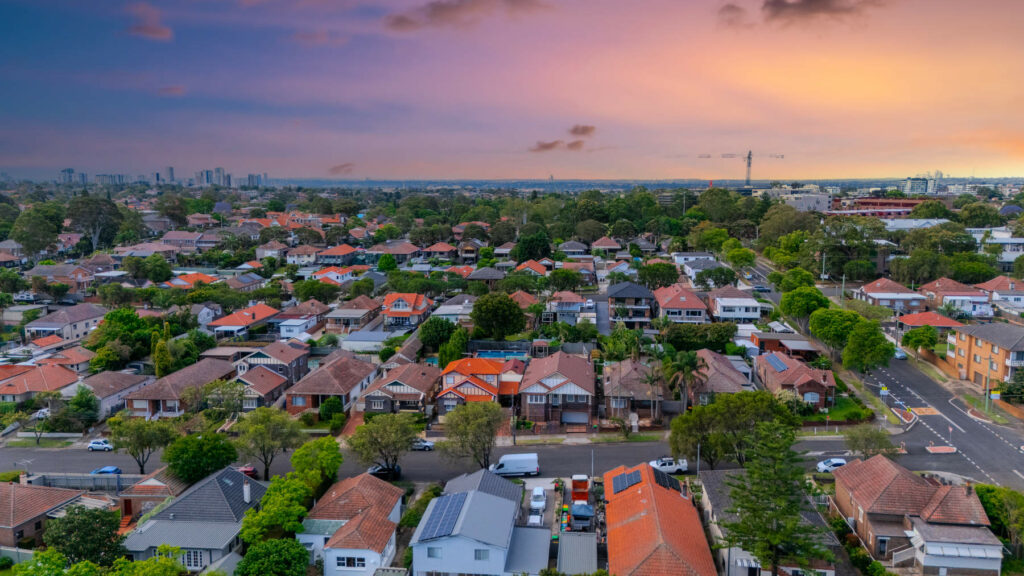
These are the spots with good transport, strong community feel and slightly better value than the beach or inner-city areas. They’re a clever choice if you’re looking for balance.
Popular areas: Marrickville, Dulwich Hill, Petersham, Ashfield, Erskineville
Best for: young couples, professionals, renters looking for space
What to expect: multicultural food, independent shops, direct trains
The Inner West is loved for its character. It may feel less polished than the east, but far more relaxed, with good cafés and a strong sense of neighbourhood.
Waterside and professional hubs
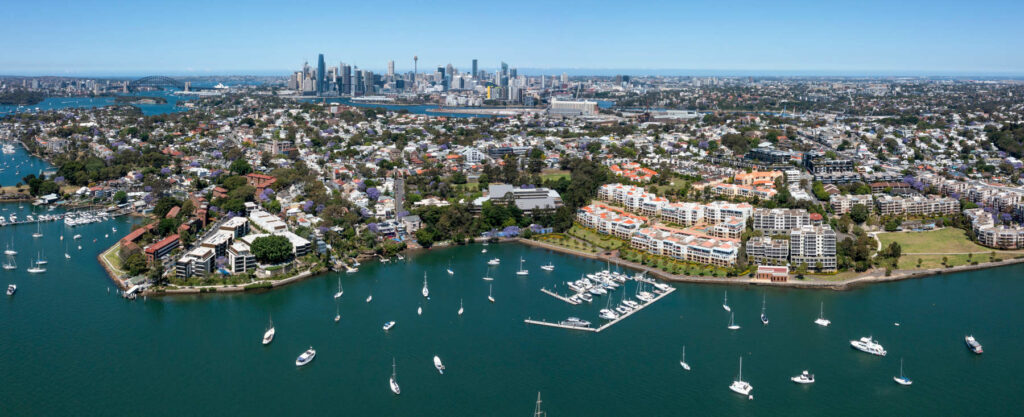
If you’re working in the CBD and want a short commute with great views, these areas hit the sweet spot.
Popular areas: Pyrmont, Barangaroo, Balmain, Kirribilli, Milsons Point
Best for: professionals, commuters, anyone wanting city convenience
What to expect: modern apartments, ferry access, quick CBD commutes
Ferry commutes from places like Kirribilli or Balmain are one of Sydney’s greatest simple pleasures.
More affordable outer suburbs
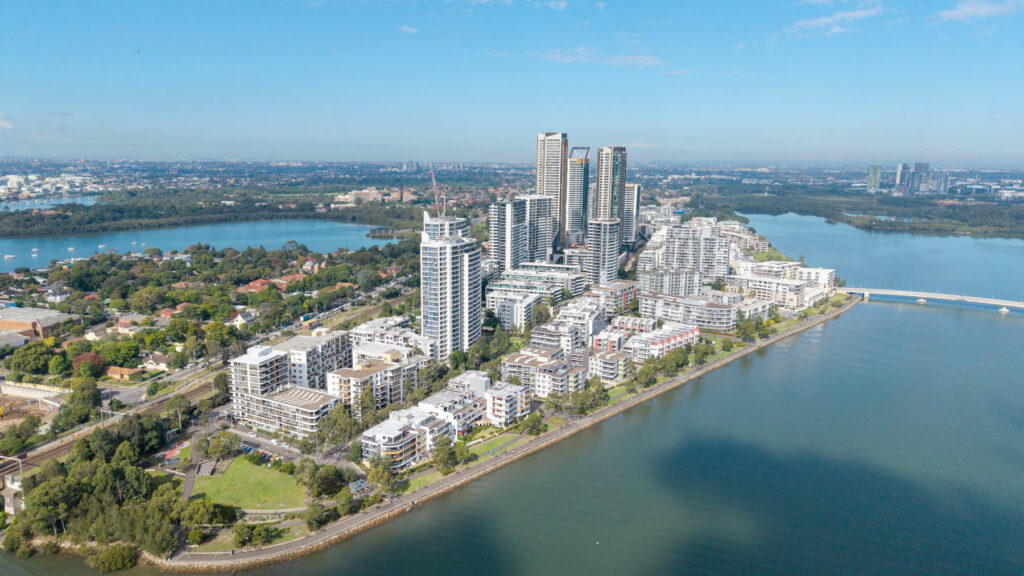
If you need more space or a gentler rent bill, looking further out doesn’t mean compromising on quality of life. Many areas offer direct trains, larger houses and a quieter pace.
Popular areas: Parramatta, Ryde, Rhodes, Homebush, Penrith
Best for: those prioritising value, larger families, long-term stays
What to expect: bigger homes, new developments, longer commutes
Parramatta is worth a special mention. It’s a major business hub in its own right and increasingly popular with professionals.
Try before you commit
Sydney is a big place, and most newcomers change suburbs after their first lease once they understand their needs better. It’s completely normal to spend your first few weeks exploring, attending inspections and getting a feel for how each area fits your daily routine.
Getting Around Sydney

Sydney’s transport network is a mix of trains, buses, ferries, light rail and toll-heavy motorways. Whether you’ll rely on public transport or a car depends almost entirely on where you live. In the right suburb, you won’t miss having a car at all. In the wrong one, you’ll feel stranded.
Public transport: what actually works
Sydney’s public transport is run through the Opal system. You can tap on with an Opal card or simply use a contactless bank card. Fares are capped daily and weekly, which helps keep costs predictable.
Trains
The train network is the backbone of the city. It’s reliable for commuting into the CBD from the North Shore, Inner West, and many outer suburbs. Trains are fast when they run smoothly, but delays do happen at peak times.
Buses
Buses fill the gaps that trains don’t reach. They’re essential for the Eastern Suburbs, the beaches, and much of the Inner West. They can be slow during rush hour, but they run frequently.
Ferries
A genuinely enjoyable way to travel. Routes from Manly, Kirribilli, Balmain and surrounding harbour suburbs offer some of the best commutes of any city in the world. They’re quick, scenic and surprisingly practical for everyday use.
Light rail
Good for specific corridors (mainly between the CBD, Surry Hills, Randwick and Dulwich Hill). Handy, but not city-wide.
When you don’t need a car
If you live in the Inner West, Eastern Suburbs, North Shore, CBD fringe or anywhere with a ferry link, you can manage perfectly well without a car. Plenty of people rely entirely on public transport for work and keep a car-free lifestyle long term.
When a car makes life easier
Sydney is spread out, and not every suburb is well connected. Families in outer suburbs, people working outside the CBD, or anyone splitting childcare and commuting often find a car essential.
Driving is familiar for UK movers — still on the left — but the city’s road layout takes getting used to. Expect tighter merging, sudden lane drops and regular toll roads.
Cycling and walking
Sydney’s cycling network has improved over the last few years but it’s still a mix of brilliant and not-so-brilliant. Some inner suburbs are easy to navigate by bike; others are better suited to confident cyclists only. Walking is excellent in most inner suburbs but less practical in outer areas.
Climate & Weather in Sydney

Sydney’s climate is one of the main reasons people move here, especially if you’re coming from the UK’s short summers and gloomy winters. The city has mild, bright winters and long, warm summers but it also has its own extremes worth knowing about before you arrive.
Warm summers
Summer in Sydney runs from December to February and can be hot. Temperatures regularly sit in the high twenties and can climb well above thirty during heatwaves. Humidity rises too, especially around January. Most homes rely heavily on fans or air conditioning, so if you’re viewing rentals in warm months, pay attention to ventilation and cooling.
Mild, sunny winters
Winters are short and very manageable. Days are often clear and crisp, and temperatures hover in the mid-teens. Many people spend winter hiking, swimming on mild days or enjoying outdoor festivals.
Rainfall and storms
Sydney gets its fair share of heavy rain, especially in autumn. Storms can be dramatic, with sudden downpours and quick-moving fronts that clear as fast as they arrive. It’s not constant, but when it rains, it can really rain.
Bushfire season
While Sydney’s urban areas are not at the same risk level as regional NSW, bushfire season is a reality in the hotter months. Suburbs close to national parks or the outer fringes of the city may experience smoke haze on some days. It’s part of living in Australia rather than a Sydney-specific issue, but worth understanding if you’re considering areas near bushland.
UV levels
One thing UK movers underestimate is the strength of the sun. UV levels in Australia are much higher than in the UK, even on mild days. Sunscreen, hats and shade become everyday habits — something you pick up quickly once you arrive.
Seasonal feel
Overall, Sydney gives you proper summers, gentle winters and plenty of sunshine throughout the year. If you’re used to planning your life around grey skies, the change is immediate and noticeable. Most newcomers find the weather improves their lifestyle without much effort — more time outdoors, more activities, and a general sense of enjoying the day rather than trying to get through it.
Cost of Living in Sydney vs the UK
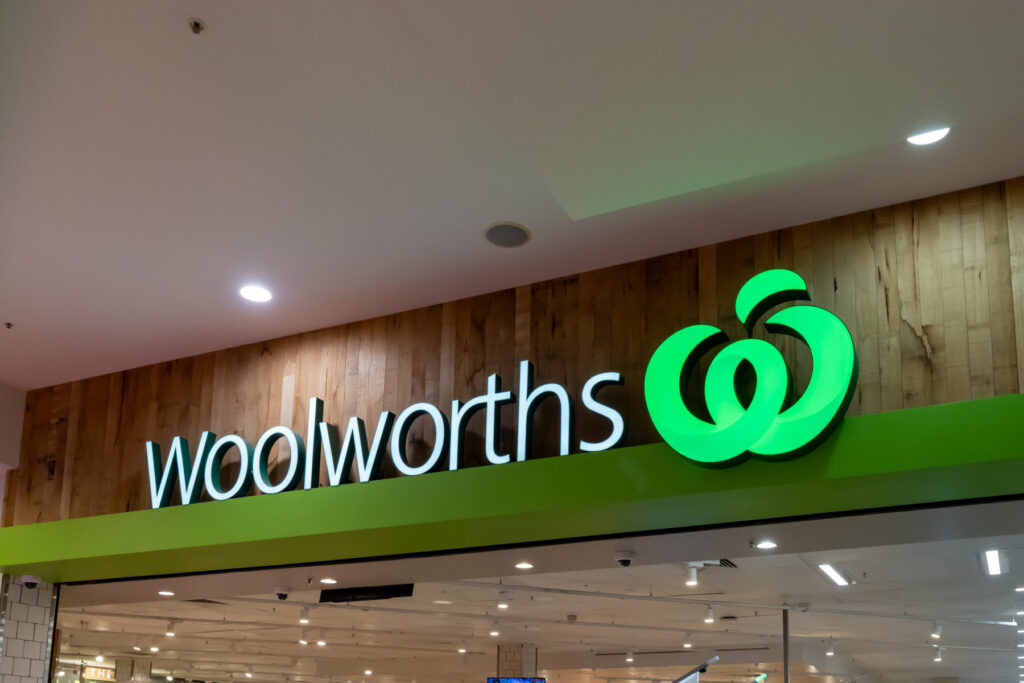
Sydney is one of the most expensive cities in Australia, and certain costs will feel higher than what you’re used to in the UK. Others may surprise you in the opposite direction. The key is understanding where the money goes so you can budget realistically for your first year.
All living costs below are taken from the Numbeo cost of living report for Sydney, and are up to date as of the time of writing. For the most update to date costs, see the report here.
Housing
This is the single biggest expense for most newcomers. Rent in Sydney is high, especially close to the beaches or inner-city neighbourhoods. If you’re used to London prices, it won’t feel wildly unfamiliar.
- Inner-city apartments and beachside suburbs sit at the top end, ranging from $3,000 to $7,000+ depending on the number of bedrooms.
- Outer suburbs offer better value ($2,300 to $4,200+) and more space but longer commutes.
Most rentals are unfurnished, which adds to initial setup costs.
Utilities
Electricity is the main cost to watch. Air conditioning in summer and heating in winter can push bills up. Water and gas are reasonable, and internet prices are broadly similar to the UK.
Combined, you can expect to pay around $300 to $400 a month on basic utilities for an 85 m2 apartment.
Groceries
Supermarket prices vary. Some basics cost more than the UK, while fresh produce can be excellent value depending on the season. Imported goods often come with a noticeable premium. Aldi helps keep costs down, while Coles and Woolworths are the main full-range supermarkets.
On average, people living in NSW pay $215 per week on groceries.
Eating out and coffee
Australia’s café culture is strong, and eating out is a normal part of life. While restaurant dining can be expensive (over $100 for a three-course meal), everyday cafés and casual spots are good value ($20-30).
Transport
Public transport costs depend on how often you travel and whether you hit the weekly fare caps. Ferry commuters can see higher fares, but it’s a trade-off for the lifestyle.
Adult single fares:
- Bus: $2.20 – $4.71
- Ferry: $6.01 – $7.50
- Train: $3.54 – $8.69
- Light rail: $2.20 – $3.66
If you drive, budget for:
- Fuel (similar or slightly higher than the UK depending on global prices)
- Tolls – See toll costs by road
- Parking, especially in inner suburbs or near the beaches
Childcare
One of the biggest surprises for UK families. Childcare costs in Sydney are high, even after government rebates.
Daycare costs can range from $100 to $200 per day, with hourly rates ranging from $15 to $20.
Healthcare
If you’re eligible for Medicare, everyday medical costs are manageable. Many people also take out private health insurance to cover extras like dental and to reduce waiting times. Compared to the US, healthcare costs are low; compared to the UK’s NHS, they may feel higher.
Expect to pay between $160 – $400+ a month on private health insurance, depending on the level of coverage.
Overall picture
The bottom line: Sydney isn’t cheap, but most movers find the quality of life balances the expense. Housing and childcare are the main costs to plan for. Groceries, eating out and transport settle into a predictable rhythm once you understand your routine. If you’re coming from London or another large UK city, the adjustment is usually manageable.
Food & Dining in Sydney

Sydney has one of the most diverse and exciting food scenes in the world. Whether you’re grabbing a quick breakfast, eating by the water or exploring the city’s multicultural pockets, food becomes a big part of everyday life.
Breakfast culture
Sydney takes breakfast seriously. Cafés open early, menus are creative and the quality is consistently high. Smashed avocado might be the cliché, but you’ll find everything from Middle Eastern-inspired plates to Japanese-style breakfasts and strong, carefully made coffee.
Casual dining
You don’t need to spend a fortune to eat well in Sydney. Neighbourhood restaurants, food halls and casual eateries cover everything from Thai and Vietnamese to Italian, Lebanese and modern Australian. Portions are generous, ingredients are fresh and the atmosphere is relaxed.
Dining by the water
The harbour and beaches shape a lot of Sydney’s dining culture. You’ll find cafés overlooking the ocean, casual fish-and-chip shops near the sand and restaurants perched above the harbour with views that feel almost unreal at first. Expect higher prices in these areas, but the experience is usually worth it.
Fresh produce and markets
With good weather and strong local farming, fresh produce is a highlight. Weekly farmers’ markets, independent grocers and Asian supermarkets make it easy to cook well at home. Seafood is a standout, particularly around the harbour and fish markets.
Eating out as part of daily life
What UK movers notice most is how normal it is to eat out several times a week. Breakfast with friends, dinner by the beach, sushi on a lunch break, it becomes part of your routine rather than a treat reserved for weekends.#
Is Dining Out Affordable Compared to the UK?
If you’re coming from London, prices will be considerably cheaper; however, in general, the cost of eating out is roughly the same or slightly cheaper than in other UK cities.
Outdoor Lifestyle and Activities in Sydney

Sydney’s outdoor lifestyle is one of the biggest reasons people move here from the UK. The weather, the coastline, the national parks and the everyday culture all push you outside without much effort. You will notice the shift almost immediately.
Beaches
Sydney’s beaches are not just scenic spots. They are part of daily life. Morning swims, coastal runs and after-work dips are completely normal. Popular beaches include Bondi, Manly, Coogee, Freshwater and Bronte. Each has its own personality, from laid back to lively.
Coastal walks
The coastline around Sydney is made for walking. The Bondi to Coogee walk is the most famous, although there are plenty of quieter options around the Northern Beaches, Watsons Bay, La Perouse and the Harbour National Park. These walks are easy to access and become part of your weekly routine.
National parks and bushwalking
Sydney is surrounded by national parks. The Royal National Park sits to the south and Ku-ring-gai Chase to the north. Both offer excellent hiking, viewpoints, swimming spots and picnic areas. It is one of the reasons the city feels so connected to nature even though it is a major urban centre.
Harbour activities
Sydney’s harbour is a natural playground. Kayaking, paddleboarding and sailing are incredibly popular. Many people join lighthearted weekend groups rather than formal clubs, which makes it easy to try new things without feeling committed.
Fitness and sport
Fitness is woven into the culture. Gyms, yoga studios, surf schools, running groups and outdoor fitness classes are everywhere. You do not need to be sporty to fit in, but you will probably find yourself moving more simply because the environment encourages it.
Wildlife and outdoor living
You will come across wildlife quickly. Kookaburras, rainbow lorikeets, possums, dolphins and the occasional water dragon are all part of everyday life. If you live near bushland, you may see more. For most newcomers, this becomes one of the unique joys of living in Australia.
The everyday outdoor routine
What surprises many UK movers is how casual outdoor living is in Sydney. Dinner outside, evening walks, beach mornings before work, picnics at short notice and weekend trips to the coast or national parks become normal habits. You do not need to plan weeks ahead or wait for a rare sunny day. The weather and lifestyle make it easy.
Schools and Education in Sydney
If you are moving to Sydney with children, the school system will be one of your biggest considerations. The structure is different from the UK, and your choice of neighbourhood will play a major role in which schools are available to you.
The basics
New South Wales has three main types of schools: public, Catholic and independent. Public schools are government funded and free to attend for most residents. Catholic schools sit in the middle in terms of cost. Independent schools are private and can be expensive.
School zones
Public schools in Sydney use catchment areas, often called zones. Your address determines which school your child is entitled to attend. This is similar to parts of the UK but taken more seriously. Many families choose their suburb based on school zones, so it is important to check zoning maps before signing a rental lease.
School year
The Australian school year runs from late January to December. There are four terms with short breaks between each one. This means your child will enter the system at a very different point compared to the UK. Most families manage the transition easily, although you may want to plan your move with the school calendar in mind.
Early childhood and childcare
Daycare and preschool places are available across the city, but costs are high and waiting lists are common. If you have young children, it is worth joining waitlists early and contacting centres before you arrive.
Universities in Sydney
Sydney has several major universities with strong global reputations. The University of Sydney, UNSW Sydney and the University of Technology Sydney (UTS) are all highly regarded for research, teaching and international student support. Macquarie University and Western Sydney University offer additional options across different parts of the city.
Undergraduate and postgraduate admission requirements vary, especially for international fee-paying students. Most institutions offer dedicated services for newcomers, including accommodation advice, enrolment support and career services. If someone in your household plans to study, it may be worth choosing a suburb with good transport links to the relevant campus.
Settling in
Children usually adapt quickly to the Australian school environment. The culture is friendly, outdoor space is part of the school routine and extracurricular sport is taken seriously. Uniforms are common in both public and private schools.
Choosing a school
It often makes sense to secure a rental home first, then visit the local schools once you arrive. Public schools are generally strong across much of Sydney, and independent schools offer additional options for families who prefer a structured or specialised environment.
Support for newcomers
Schools are used to international arrivals and usually help children integrate into their year groups. For students who need extra support with English, many public schools offer free language programs to assist with the transition.
Healthcare in Sydney
One of the most reassuring parts of moving to Australia is the quality of its healthcare system. Sydney has excellent hospitals, modern clinics and a mix of public and private services. If you are moving from the UK, you will find some things familiar and others very different.
Medicare
Medicare is Australia’s public healthcare system. It covers visits to GPs, public hospitals and a range of essential treatments. Many UK citizens on eligible visas can enrol in Medicare soon after arriving. Once registered, you simply show your Medicare card at appointments to access subsidised care.
Medicare does not cover everything. Dental work, optical care and some specialist treatments may require private insurance or out-of-pocket payments. It is not the same as the NHS, although it provides a solid level of support for everyday medical needs.
Private health insurance
A large number of Sydney residents choose private health insurance. It fills the gaps that Medicare does not cover and can reduce waiting times for some procedures. Many policies bundle extras such as dental and physio.
If your visa requires private health cover, you will need a compliant policy before entering the country. Even if it is not compulsory, it is worth reviewing your options once you have settled in.
GP and specialist visits
Finding a GP is straightforward. Local clinics are spread throughout the city, and many accept new patients. Some appointments are fully bulk billed which means Medicare covers the cost. Others charge a fee with Medicare reimbursing a portion.
Specialist care works through referrals from your GP. The system is organised and easy to navigate once you understand the sequence.
Pharmacies
Pharmacies in Sydney operate like those in the UK. Many common medicines are available over the counter. Prescription medications are subsidised through the Pharmaceutical Benefits Scheme, which helps keep costs predictable.
Hospitals
Sydney has a mix of public and private hospitals. Public hospitals provide excellent emergency and essential care. Private hospitals offer shorter wait times and wider choice in specialists. You can use both depending on your insurance and the treatment you need.
Everyday healthcare experience
Most newcomers find the Australian healthcare system efficient, modern and easy to use. The biggest adjustment for UK movers is paying small fees for routine visits and deciding whether to take out private insurance. Once you understand how Medicare and private cover work together, the system becomes simple to manage.

